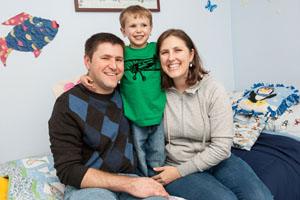January 24, 2014 - By Winter Johnson

Aiden Hansen, standing between parents Jesse and Shifra Hansen, needs a heart transplant.
With 19 heart transplants, 2013 was the busiest year ever for the Children's Heart Center at Lucile Packard Children's Hospital Stanford, home to the only pediatric heart transplant program in Northern California. The success offers hope for those still waiting for this lifesaving gift.
One such patient is 4-year-old Aiden Hansen, who doesn't let the combination of his rare, hypoplastic left heart syndrome and heterotaxy syndrome stop him from loving planes, cars and going to music classes. When he was only 3 days old, his doctors in Santa Rosa suspected something was very wrong. A series of echocardiograms and ultrasounds revealed that his heart had a missing ventricle, his liver and stomach were in the wrong place, and he had multiple spleens. Parents Jesse and Shifra Hansen then brought Aiden to Lucile Packard Children's Hospital Stanford.
Aiden had his first open-heart surgery when he was 10 days old under the hands of Mohan Reddy, MD, a professor of cardiothoracic surgery and of pediatrics at the School of Medicine. Over the years, Aiden has had three open-heart surgeries and a pacemaker implanted. Now he and his family are eagerly waiting for a donor heart.
Providing hope for kids like Aiden are the 19 heart transplant patients from 2013. Athlete and sports nut Gavin Jack of Soquel, Calif., is in that club. Last October, the 18-year-old received a donor heart in a transplant surgery led by Katsuhide Maeda, MD, clinical assistant professor of cardiothoracic surgery. "Gavin's recovery since his transplant has been amazing," said his mother, Michele Parker, who expressed her extraordinary gratitude for the gift of organ donation.
Patient families know that it takes a village to provide world-class, nurturing care before, during and after a heart transplant. "We have extraordinary experience," said David Rosenthal, MD, director of the hospital's pediatric heart failure program and professor of pediatric cardiology. Rosenthal noted that the hospital's busiest year before 2013 was 2009, with 17 transplants.
"Teams across the hospital understand the difficulties these patients and families are facing," he said.
Success rates for pediatric heart transplants nationwide have risen over time. In general, there is a 90 percent survival rate for transplanted patients at the one-year point. At three years, there is an 80 to 85 percent survival rate. At five years, 75 to 80 percent. After that, survival rates become increasingly hard to trace because the treatments and protocols are constantly evolving.
"The heart failure and transplant teams in the Children's Heart Center are grateful to have helped 19 children with lifesaving heart transplants in 2013," said Stephen Roth, MD, MPH, director of the center and professor of pediatric cardiology. "As our program expands, we are treating more children from California and the western United States with severe heart failure each year."
About Stanford Medicine
Stanford Medicine is an integrated academic health system comprising the Stanford School of Medicine and adult and pediatric health care delivery systems. Together, they harness the full potential of biomedicine through collaborative research, education and clinical care for patients. For more information, please visit med.stanford.edu.